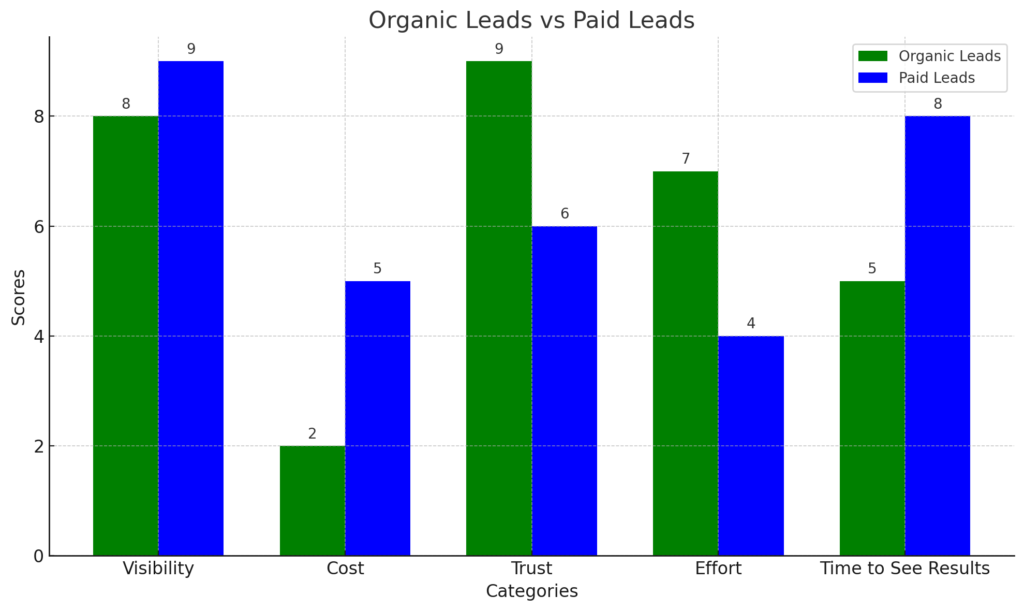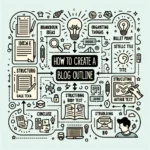
It’s a vital component of digital marketing that’s frequently overlooked, as it occurs before any direct interaction with potential customers. Lead generation involves identifying and attracting people who are likely interested in a company’s products or services, turning strangers into prospects.
In this article, we’ll discuss what lead generation entails, along with its benefits and challenges for businesses. This process not only helps in building a sales pipeline but also plays a crucial role in a company’s growth strategy by opening up new avenues for customer engagement and conversion.
What Is Lead Generation in Digital Marketing?
Lead generation is super important for any business diving into digital marketing. It’s all about understanding who might be interested in what you’re selling before you even talk to them.
Think about how things have changed. It used to be all about ads in newspapers or handing out flyers. Not anymore. Now, it’s about knowing exactly who your customers could be, thanks to the internet and some smart tools that analyze information—kind of like using a superhero gadget to see through walls, but with data.
You get to be really specific about who you talk to, what you say, and when you say it. It’s like planning a trip starting from your destination and working backward. Super cool, right?
Keeping up with all the changes in how we do business online is a must. That’s where social media and search engines come in. They’re like the big players in getting your business out there for people to see. They set the stage for just about every online marketing thing you see these days.
What Is a Lead And Why Do You Need It?
A lead is someone who might be interested in what your business has to offer. They show this by reaching out in some way, like through email, phone calls, or social media, or by responding to an offer or trial you’ve put out there. Unlike the old-school method of cold calling, which is pretty much out of style, direct response lead generation is about drawing in potential customers who’ve already shown some level of interest.
For example, imagine you fill out a survey because you really like a brand, and they give you a discount voucher in return. When you accept this voucher, you also give them your contact info. This trade-off is a win-win. You get a discount, and the company gets a chance to communicate with you, hoping to turn you into a customer.
This exchange warms you up for a future conversation with the company. It’s not just about getting a discount; it’s about opening a line of communication. For businesses, the details you share are gold. They use this info to tailor their messages and offers to meet your interests, which makes their marketing efforts more efficient and targeted.
Why are leads essential? They help businesses understand who is interested in their products or services. This understanding includes knowing the potential customers’ needs, interests, and the best time and way to reach them. Lead generation offers a pathway for businesses to attract people who have shown interest in their offerings, making it easier to engage with prospects effectively.
It’s about connecting with those who are more likely to want what you’re selling, saving time and effort by focusing on the right people.
The Two Main Areas Of Focus For Lead Generation
B2B Lead Generation
B2B Lead Generation, or Business-To-Business Lead Generation, is a critical element of the sales process, focusing on activities that attract potential business clients into your sales funnel. These activities are designed to bring in new leads who are likely interested in purchasing your products or services.
The aim here is to improve both the quality and quantity of leads by identifying potential clients interested in changing suppliers, purchasing additional products, or subscribing to trials. This form of lead generation is strategic and often requires a tailored approach to engage potential business customers effectively.
B2C Lead Generation
In contrast, B2C Lead Generation targets individual consumers rather than businesses. This process involves marketing efforts that attract a high volume of quality leads through various channels such as search engines, social media, and referrals.
The key for B2C is to gather as many leads as possible to quickly move them through the sales funnel, leveraging speed for competitive advantage. Achieving this requires efficient lead generation strategies, often utilizing inbound marketing techniques, followed by nurturing these leads with automated tools to engage and convert them into customers. The focus here is on reaching a broad audience and converting interest into sales rapidly.
In summary, while B2B Lead Generation is about building strategic relationships with potential business clients through a focused and tailored approach, B2C Lead Generation aims at quickly attracting and converting a large volume of individual consumers through broad-reaching marketing strategies.
Types of Leads
Understanding the different types of leads is crucial for tailoring your approach to each potential customer. Not every lead is the same, and recognizing how they vary can significantly impact your strategy for engaging and converting them.
Marketing Qualified Leads (MQLs)
Marketing Qualified Leads are contacts who have shown interest in your marketing content but are not yet ready to engage in a sales conversation. These leads might have filled out a form on your website to get a discount code or signed up for a free trial. They’re interested but need more nurturing before they’re ready to buy.
Sales Qualified Leads (SQLs)
Sales Qualified Leads are a step ahead of MQLs. These contacts have demonstrated a clearer intention to purchase your product or service. For example, they might have completed a form on your website with specific questions about your offerings. SQLs are ready for a direct sales approach because they’ve shown a more serious interest in what you’re selling.
Service Qualified Leads
Service Qualified Leads are those individuals who have expressed a desire to become paying customers through interactions with your customer service team. An example might be someone who has contacted customer support to inquire about upgrading their current plan or subscription. These leads are valuable because they’ve already engaged with your product or service and are considering taking their relationship with your company to the next level.
Product Qualified Leads (PQLs)
Product Qualified Leads have used your product (often through a free trial or a freemium model) and have taken actions that indicate a strong interest in making a purchase. For instance, a customer using the free version of your software who frequently inquires about features available in the paid version is showing clear buying signals.
PQLs are crucial for businesses offering digital or experiential trials, as these leads have firsthand experience with your product and a vested interest in its full capabilities.
By distinguishing between these types of leads, businesses can more effectively target their communications and convert prospects into paying customers. Each type requires a different strategy and level of engagement, underscoring the importance of a nuanced approach to lead management.
Different Types of Lead Generation Marketing Platforms
Writing Content
Creating engaging content is a foundational strategy for leading users to your landing page. The idea is to craft articles or blog posts that not only inform and entertain your audience but also include compelling calls-to-action (CTAs) throughout. These CTAs encourage readers to click through to your landing page, moving them closer to becoming leads. The more valuable and relevant your content is, the higher the chances your audience will engage with your CTAs.
Email Marketing
Email marketing involves reaching out to people who already know your brand and might be interested in what you have to offer. By sending targeted email campaigns, you can use CTAs that draw these contacts toward your products or services. The effectiveness of email marketing relies on crafting messages that resonate with your audience, using eye-catching designs and persuasive copy in your CTAs to maximize engagement.
Paid Ads / Remarketing
Paid ads and remarketing efforts are focused on prompting a specific action from viewers, such as visiting a landing page or making a purchase. It’s crucial that the offer on the landing page matches the promise made in the ad to avoid confusion. Effective ad campaigns require careful planning beyond the ad itself, ensuring that there’s a clear path for the audience to follow once they’ve clicked through.
Social Media Marketing
Social media platforms offer a dynamic environment for promoting your products or services and guiding customers to take specific actions. Whether through social shares, calls-to-action in posts, or clickable links in Instagram stories or Facebook bios, social media makes it easy to direct followers to your landing page. By leveraging the unique features of each platform, you can encourage your audience to engage with your brand and move further down the sales funnel.
Why Lead Generation is Important for Businesses
Lead generation stands as a cornerstone in the foundation of modern digital marketing strategies, playing a pivotal role in the success and growth of businesses across various industries. It’s not just about attracting any audience; it’s about attracting the right audience. Here’s why lead generation is indispensable:
- Targets the Right Audience: By focusing on lead generation, businesses can more accurately identify and target individuals who are most likely to purchase their products or services. This precision targeting ensures that marketing efforts are concentrated on a receptive audience, improving overall efficiency and effectiveness.
- Enhances Customer Engagement: Engaging with potential customers early in their journey helps businesses establish a connection and build trust. Effective lead generation strategies involve interactive content, social media engagement, and personalized communication, all of which contribute to a stronger relationship with prospective buyers.
- Increases Conversion Rates: With a well-defined lead generation process, businesses can increase their conversion rates. By nurturing leads through tailored content and communication, potential customers are more likely to make a purchase. This direct approach to guiding prospects through the buying journey results in higher conversion rates and more sales.
- Drives Revenue Growth: Ultimately, the goal of lead generation is to drive revenue. By generating high-quality leads that are more likely to convert, businesses can significantly increase their sales and revenue. This growth is essential for expansion, allowing companies to invest in new products, enter new markets, and scale their operations.
- Provides Valuable Insights: Lead generation also offers valuable insights into market trends, customer preferences, and the effectiveness of marketing strategies. This information is crucial for refining marketing efforts, developing new products, and staying ahead of the competition.
In the digital age, where competition is fierce and customer attention is fragmented, lead generation provides a structured approach to attract, engage, and convert potential customers. It’s a strategic process that not only fills the sales pipeline but also aligns marketing efforts with the needs and interests of the target audience, ensuring that businesses stay relevant and competitive.
How You Can Generate Leads for Your Business
Generating leads is essential in the modern digital landscape where informed and savvy customers have a wealth of options at their fingertips. Here’s a concise guide to jumpstart your lead generation efforts:
- Basic Local SEO: Start by ensuring your business ranks well in local search results. This makes you more visible to potential customers searching for your products or services nearby.
- Google My Business: Claim and optimize your listing. This free tool boosts your visibility in local searches and Google Maps, making it easier for customers to find you.
- Publish Content Regularly: Keep your audience engaged and attract new visitors by consistently publishing valuable content on your website or blog.
- Guest Posting: Write articles for other websites in your industry. This can expand your reach and attract leads from new sources.
- Social Media Engagement: Be active on the social media platforms your target audience uses. Regular posts, interactions, and promotions can draw attention to your brand.
- Paid Search Ads: Utilize search engine advertising to place your business in front of people actively looking for what you offer.
- Social Media Ads: Target potential customers on social media with ads tailored to their interests and behaviors.
- Native Advertising: Place your ads on platforms where they’ll blend seamlessly with the surrounding content, attracting leads without being intrusive.
- Build a Referral Network: Encourage happy customers and partners to refer others to your business. Personal recommendations can be incredibly effective.
The marketing world has evolved, with customers now more informed and discerning than ever before. They arrive at your digital doorstep armed with knowledge, making it crucial to stand out and effectively communicate your value proposition. By implementing the strategies above, you can attract and engage potential customers, guiding them from discovery to decision with confidence.
Difference Between Organic and Paid Leads
Imagine you have a lemonade stand. Getting customers can happen in two main ways: either they just walk up to your stand because they saw it while passing by (organic), or you put up signs around the neighborhood to tell them exactly where to find you (paid).
Organic Leads are like the first group. These are people who find your business naturally, like through searching online or seeing a post from your blog. For example, if someone Googles “best lemonade near me” and your lemonade stand’s website pops up, they click on it, and decide they want to buy your lemonade, that’s an organic lead. You didn’t pay for them to find you; they just did because you were exactly what they were looking for.
Paid Leads come from you spending money to get people’s attention. This is like putting up those signs or ads online that say, “Visit our awesome lemonade stand at the corner of 5th and Main!” If someone sees your ad on social media, clicks on it, and decides they want some lemonade, that’s a paid lead. You paid for the ad to get them to notice you.
So, the main difference? Organic leads find you on their own because you match what they’re looking for, while paid leads find you because you reached out to them with ads or promotions. Both ways can bring people to your lemonade stand, but they find out about it differently.

The Right Tools to Generate Leads
Having the correct tools in your lead generation toolkit can dramatically improve the success rate of your campaigns. Whether it’s capturing customer information or driving traffic, the efficiency of these processes greatly depends on the software you use. Here are some of the top tools that can help you generate more leads and increase sales in less time.
HubSpot
HubSpot is an all-in-one inbound marketing, sales, and service platform that helps companies attract visitors, convert leads, and close customers. It features tools for email marketing, social media marketing, and content management.
Salesforce
Salesforce is a cloud-based CRM software that enables businesses to manage their sales, marketing, and customer support facets of their business. It’s known for its lead management, sales forecasting, and analytics.
Mailchimp
Mailchimp is an all-in-one marketing platform that helps you manage and talk to your clients, customers, and other interested parties. Its focus is on automated marketing emails, targeted ad campaigns, and analytics.
Leadfeeder
Leadfeeder identifies companies that visit your website, how they found you, and what they’re interested in. It integrates with your CRM and email marketing tools to boost your sales intelligence.
SEMrush
SEMrush is a powerful and versatile competitive intelligence suite for online marketing, from SEO and PPC to social media and video advertising research. It’s great for finding opportunities to generate leads through online channels.
Each of these tools has its own strengths, and choosing the right one depends on your specific needs and strategy. Implementing them in your lead generation efforts can provide a significant boost to your campaign’s success rate.
Final Thoughts
Lead generation in digital marketing is essential, demanding more than half of your marketing budget for good reason. It’s not just a one-time tactic; it should be a fundamental part of your business strategy, focusing on creating customer-friendly experiences right from the start. Staying updated with the latest trends in lead generation is challenging but crucial for advancing your business and career. Remember, we’re always here to help and discuss any questions you might have.





